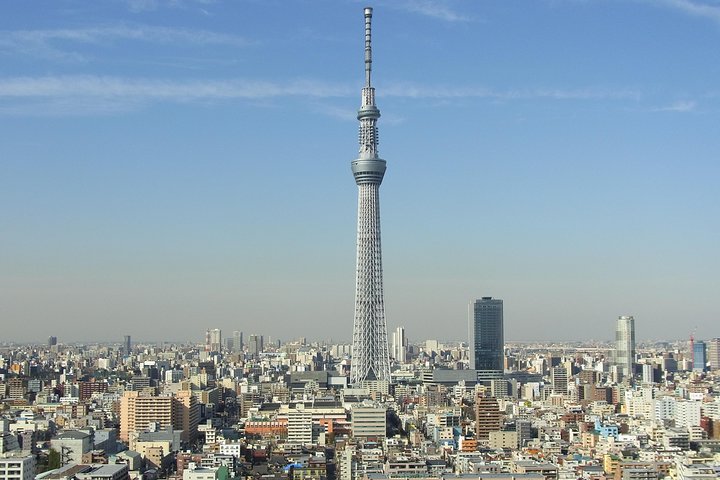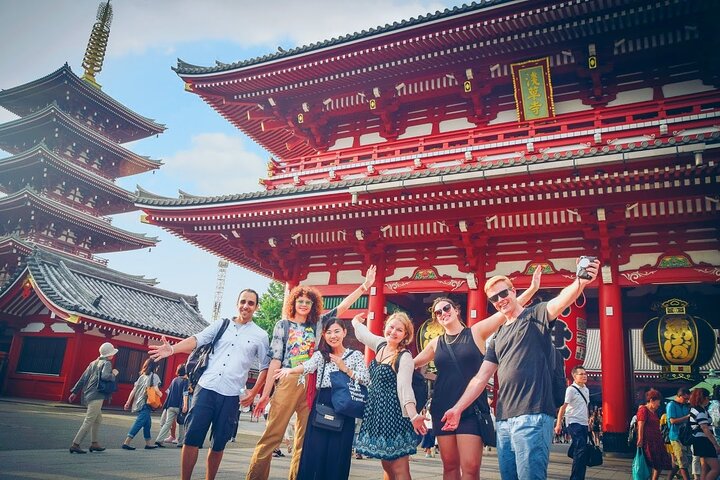5 Day Best of Japan Tokyo to Kyoto Small Group Tour
Tổng quát
Ngôn ngữ có sẵn
120 giờ
Vé di động
What makes this tour unique is its intimate small-group format (max 15 people), which ensures personalized attention and a relaxed pace. You’ll experience **Japan’s iconic highlights—from Tokyo’s bustle to Kyoto’s tranquil temples—via the efficient shinkansen (bullet train). Every detail is covered: all transport, accommodation, meals, guided tours, Cross Shibuya's famous intersection,Explore the ancient Senso-ji Temple,Admire the golden Kinkaku-ji Temple in Kyoto Stroll through Kyoto's historic Gion district. With expert English‐speaking guides leading every step, you gain deep cultural insights beyond the surface.
Thông tin khác
Wheelchair accessible
Infants and small children can ride in a pram or stroller
Public transportation options are available nearby
Infants are required to sit on an adult’s lap
Transportation options are wheelchair accessible
All areas and surfaces are wheelchair accessible
Not recommended for travelers with spinal injuries
Not recommended for pregnant travelers
Not recommended for travelers with poor cardiovascular health
Suitable for all physical fitness levels
Chính sách hủy
All sales are final. No refund is available for cancellations.
Bao gồm
Entrance fees for mentioned sights visited.
Hotel accommodation with twin-sharing basis
Minbus with driver
Service of English speaking guide per itinerary
Public transport like express bus/train, bullet train during the trip
International flight into Tokyo and out of Osaka.
Japan visa fee.
Gratuities
Lunch and dinner
airport pick-up service
Cần Quan Tâm
Tokyo, Japan Arrival
Lưu Trú
Shibuya Excel Hotel Tokyu(4-star hotel)
Tokyo
Upon your arrival in Tokyo, Japan, head to your hotel on your own.Welcome to Tokyo! Once you arrive and check in at the hostel you’ll then have plenty of time to recover from your flight and relax before you meet everyone in your group. If you require airport pick-up service, please let us know in advance. We can arrange a private transfer from the airport to your hotel for you. Please note that this service comes with an additional cost.
Tokyo Tour | Meiji Jingu Shrine, Shibuya Crossing, Hachiko statue, Senso-ji Temple, Tsukiji Fish Market
Lưu Trú
Shibuya Excel Hotel Tokyu(4-star hotel)
Đồ ăn và uống
BREAKFAST
Breakfast
Meiji Jingu Shrine
After breakfast, you will be guided to visit Meiji Jingu (Meiji Shrine), located in the heart of Tokyo. This important Shinto shrine honors Emperor Meiji and Empress Shoken, and is known for its peaceful atmosphere surrounded by towering ancient trees. Upon entering, you will walk through Japan's largest wooden torii gate, which symbolizes the entrance to the sacred realm, separating the divine world from the human world.
Shibuya Crossing
Next, you will visit Shibuya Crossing, one of Tokyo’s most iconic landmarks. Known as one of the busiest intersections in the world, it sees up to 3,000 pedestrians crossing in just two minutes, drawing visitors from all over the world for photos.
Statue of Hachiko & Hidesaburo Ueno
It has also been featured in numerous films, TV shows, and commercials, including Furious 7. If you're a fan of the story of Hachiko, the loyal dog, you can also visit the statue of Hachiko outside Shibuya Station, symbolizing loyalty and love.
Senso-ji Temple
In the afternoon, you will proceed to Senso-ji Temple, built in 645 AD, which is one of Tokyo's oldest and most famous Buddhist temples, dedicated primarily to Kannon, the goddess of mercy. The temple entrance is marked by the iconic Kaminarimon Gate, featuring a large red lantern, with statues of the Wind God and Thunder God on either side, symbolizing protection against evil spirits.
Nakamise Shopping Street (Kaminarimon)
Beyond the gate lies Nakamise Shopping Street, a historic commercial street lined with shops selling traditional Japanese snacks, crafts, and souvenirs. Walking through this street leads to the Hozomon Gate, beyond which stands the main hall, where many worshippers come to pray. Adjacent to the hall is the five-storied pagoda, representing the five elements of Buddhism — earth, water, fire, wind, and space — and exemplifying traditional Japanese architectural style. From the southern side of Senso-ji, you can also view Tokyo Skytree, Japan's tallest tower.
Tsukiji Fish Market
Later, you will visit the Tsukiji Fish Market, once the world’s largest fish market and famous for its tuna auctions. Although the wholesale and auction areas have now moved, the outer market remains a great place to enjoy fresh sushi, sashimi, seafood, and other Japanese delicacies at local restaurants. You can also explore the kitchenware shops and learn about different types of seafood and how they are prepared and enjoyed in Japanese cuisine.
Tokyo to Kyoto by Shinkansen (Bullet Train) | Kinkakuji Temple, Nijo Castle
Lưu Trú
KYOTO TOKYU HOTEL(4-star hotel)
Đồ ăn và uống
BREAKFAST
Breakfast
Kyoto
After breakfast, our driver will take you to Tokyo Station, where you will board the Shinkansen (bullet train) to Kyoto Station — a journey of approximately 2.5 hours. Along the way, you can enjoy scenic views of Japan’s urban and rural landscapes.
Kinkakuji Temple
In the afternoon, you will visit Kinkaku-ji Temple (Golden Pavilion), also known as Rokuon-ji Temple, one of Kyoto’s most iconic landmarks. Originally built in 1397 as a villa for Shogun Ashikaga Yoshimitsu, it was later converted into a Zen temple and was designated a UNESCO World Heritage Site in 1994. The main highlight is the three-story pavilion covered entirely in gold leaf, known as the Kinkaku (Golden Pavilion). On clear days, its dazzling reflection shimmers in the tranquil pond in front, creating a breathtaking sight. During autumn, the golden pavilion is beautifully contrasted against the vibrant red leaves surrounding it, making it an especially unforgettable experience.
Nijo Castle
Following this, you will continue to another World Cultural Heritage site — Nijo Castle. Originally constructed in 1603, it served as the Kyoto residence of Tokugawa Ieyasu and symbolized the power of the Edo Shogunate. It played a significant role in Japanese history, where the shogunate finally returned power to Emperor Meiji in 1867. At Nijo Castle, you can explore the well-preserved Edo-period architecture, view cultural and artistic paintings from that era, and learn about the castle’s defensive features, such as high walls, moats, and the famous "nightingale floors" — creaky wooden corridors designed to alert guards of intruders. In addition, the beautiful Ninomaru Garden, designed by tea master and landscape architect Kobori Enshu, is definitely worth a visit. After the tour, you will return to your hotel for rest.
Kyoto Tour | Fushimi Inari Taisha Shrine, Kiyomizudera Temple, Ninenzaka & Sannenzaka, Yasaka Shrine, Gion
Lưu Trú
KYOTO TOKYU HOTEL(4-star hotel)
Đồ ăn và uống
BREAKFAST
Breakfast
Fushimi Inari-taisha Shrine
After breakfast, you will visit Fushimi Inari Taisha Shrine, one of Japan’s most beautiful shrines. Established in 711 AD, it is one of Kyoto’s most popular and spiritually significant shrines, dedicated primarily to Inari-no-Okami, the Shinto deity of rice, agriculture, business, and safe travel. Many locals come here to pray for bountiful harvests, business success, and safe journeys. Tips: A round-trip hike to the summit takes about two to three hours, but we recommend walking only as far as the Four-Way Crossroads (Shichishito-no-Saka) halfway up the mountain. Beyond this point, the number of torii decreases, and from here you can already enjoy a panoramic view of Kyoto. The walk to the crossroads takes approximately 30–40 minutes.
Kiyomizu-dera Temple
Next, you will proceed to Kiyomizu-dera Temple, Kyoto’s oldest and most revered Buddhist temple. Originally built in 778 AD, it is famous for its wooden stage, known as the “Kiyomizu Stage,” which extends dramatically over the hillside and is designated a National Treasure of Japan. The main hall is an architectural marvel — constructed entirely without nails. Within the temple grounds, the sacred Otowa Waterfall flows into three separate streams, believed to grant wishes for longevity, wisdom, and health. Many visitors stop to drink from these waters. Additionally, Kiyomizu-dera is a renowned spot for cherry blossom viewing in spring and autumn foliage in fall.
Sannenzaka Ninenzaka
After the tour, you will take a short walk to explore the well-preserved historic streets of Ninenzaka and Sannenzaka, two charming sloped lanes filled with traditional Japanese shops, teahouses, and local crafts. Walking through these neighborhoods feels like stepping back in time to old Kyoto. You’ll have time to browse unique souvenirs, try local snacks, or relax in a cozy café and soak in the peaceful atmosphere.
Yasaka Shrine
You will then continue to Yasaka Shrine (also known as Gion Shrine), located in the heart of the Gion district. With a history dating back more than 1,350 years, Yasaka Shrine is especially popular among those seeking beauty and prosperity, as it is believed that visiting the shrine brings good fortune. It is also famous for the Gion Matsuri, held every July — one of Japan’s grandest and most celebrated festivals, and one of the country’s three great summer festivals.
Gion
Finally, you will explore the nearby Gion district, Kyoto’s most famous and historic geisha quarter. Here, you may encounter real geiko (Kyoto-style geisha) and maiko (apprentice geisha) dressed in elegant kimonos and traditional makeup. Stroll along Gion’s quiet streets, where beautifully preserved machiya townhouses, chaya tea houses, and traditional Japanese restaurants line the roads. As dusk falls, lanterns light up the narrow alleys, and it's common to see geiko and maiko heading to evening appointments, adding a touch of timeless elegance to the neighborhood.
Kyoto Departure
Kyoto
Depart from Kyoto to Osaka and transfer to the airport on your own. If you require airport drop-off service, please let us know in advance. We can arrange a private transfer from your hotel to the airport for you. Please note that this service comes with an additional cost.
Tùy chọn
5 Day Best of Japan: Tokyo to Kyoto Small Group Tour
Peak season
Peak season
Trải nghiệm liên quan
Vận hành bởi UME Travel























